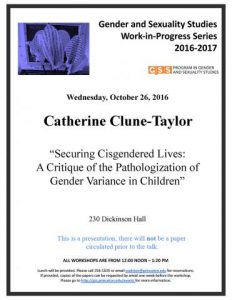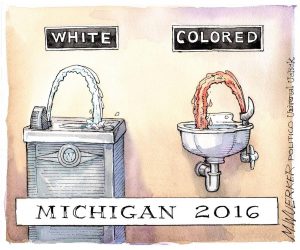The poem included at the end of this post is titled “Rebirth” and is authored by Sarah Tsigeyu Sharp. I found the work in “Sovereign Erotics: A Collection of Two-Spirit Literature” edited by Qwo-Li Driskill, Daniel Heath Justice, Deborah Miranda, and Lisa Tatonetti. The collection of poems centers the voices of indigenous, non-binary, two-spirit folks in an attempt to fill a gap in currently available materials of trans, queer, and indigenous literature. I came across this work while researching non-binary identities of color over the summer. Based on her biography in the “About the Contributors” section of the book: “Sarah Tsigeyu Sharp is a two-spirit, undocumented Cherokee/Lakota mother of three who strives to regift her traditions to her children.” Sarah dedicates her time to preserving endangered foods and medicine plants of native origin for local tribes and trains individuals on her preservation work (Sovereign Erotics, 221).
“Rebirth” details the journey of an indigenous individual finding themself in a process of rebirth with the help of an ambiguous partner of indigenous descent. We know that the partner is indigenous because of the protagonist’s knowledge that a “day would come when indigenous lifts indigenous closer to the sun.” It is insinuated that the partner is godly in character based on their superhuman capabilities. The partner knows multiple languages and is able to teach the protagonist “Taíno, Carib, Guanahatabey, español y poco niño ingles.” The partner is also capable of affecting parts of the protagonist’s body with parts of their own, although it seems that the partner does not have a material body. The reader gets the sense that the partner’s body may encompass the world as we know it and beyond that.
The poem showcases continuous cycles of rebirth of a physical and spiritual nature. Furthermore, the poem sustains a “dialogue of rebirth” in its literal written or spoken form and in the image it draws of indigenous rebirth through a communal sense of nature and an oral tradition.
The connection I would like to discuss is the relation between the imagery of Sarah Tsigeyu Sharp’s “Rebirth” and a course theme of calculating/contextualizing the body and mind. In thinking through current and future characteristics of living laboratories, we were put in a position of thinking through how to best represent bodies in systematic ways. “Rebirth” also calls this process into question with its juxtaposition of numbers in relation to immeasurable, abstract concepts. How we can measure the body or a people with modern medicine, science, or knowledge?
It is interesting how the Taino sun is centered near the end of this work. The Taíno are an indigenous tribe in the Caribbean almost completely wiped out by Columbus’s colonization. They are often a subject of study albeit in indirect, vague, and colonial ways. Although I have not read much research on the Tainos or Taíno topics, I have picked up that they are often studied through their medicinal practices and in very physical ways. After enrolling in this course I have realized that we continue to make a racialized and gendered laboratory of the Taíno people that posthumously, violently medicalizes them. Can creative works be a possible avenue to redesign how we uplift minoritized voices, much like Sarah Tsigeyu sharp does in her work for indigenous voices?
Note: A second connection I would have made is the similarity in indigenous themes between Sarah Tsigeyu Sharp’s “Rebirth” and Anzaldúa’s “Borderlands/La Frontera.” However, my post was already too long. Similar techniques to think about are: multiple/hybrid languages; connection of indigenous lives to the land and nature; intercise of being indigenous but also colonized.
Rebirth by Sarah Tsigeyu Sharp
Source: Sovereign Erotics: A Collection of Two-Spirit Literature edited by Qwo-Li Driskill, Daniel Heath Justice, Deborah Miranda, and Lisa Tatonetti (pp.198-199)
We etch home into the palms of our hands
lift them toward the moon, that they might be
magnified by her glory
Dangle feet over boulders in the river
Close eyes tight, pretend these are our homelands
Remember past tanglings of spit
and weavings of skin that brought us here,
Birthed us, brought honey to our trembling lips,
food and sweetness for the fight ahead.
Today is a good day to cry.
Your eyes like an amber cavern in a thunderstorm
and as bright as the day is long
I shudder under you as your tongue teaches my
body to speak
Taíno, Carib, Guanahatabey, español y poco niño ingles
You are a dialect unto yourself
I was the furthest East I’d ever been,
more than 2900 miles from home
you, redefining the word with you small hands
I could push sand into your mouth to stifle my terror
lest you speak,
break me into bits and I should tumble down your
throat the end of me
But you and the Taíno sun are inside me now,
for good
Then, 41000 feet in the sky, heading steadily away
from you
I cherish the flush/of my lust
You grated me my own heat, bottled tight inside
my frigid, North American heart,
a product of the colonization of my people
We were once as wild as you/
some of us still are
some of us just need a little help from our liberated kin
thus, I name you such:
Kin, Sibling in Struggle
I knew the day would come when indigenous lifts
indigenous closer to the sun,
I just never could have guessed it would be like this:
you, all eyes and hands and tongue
You are acts of gods exiled long ago
from this, our fertile earth
You and I
a dialogue
of rebirth

 http://usuncut.com/class-war/politico-flint/
http://usuncut.com/class-war/politico-flint/